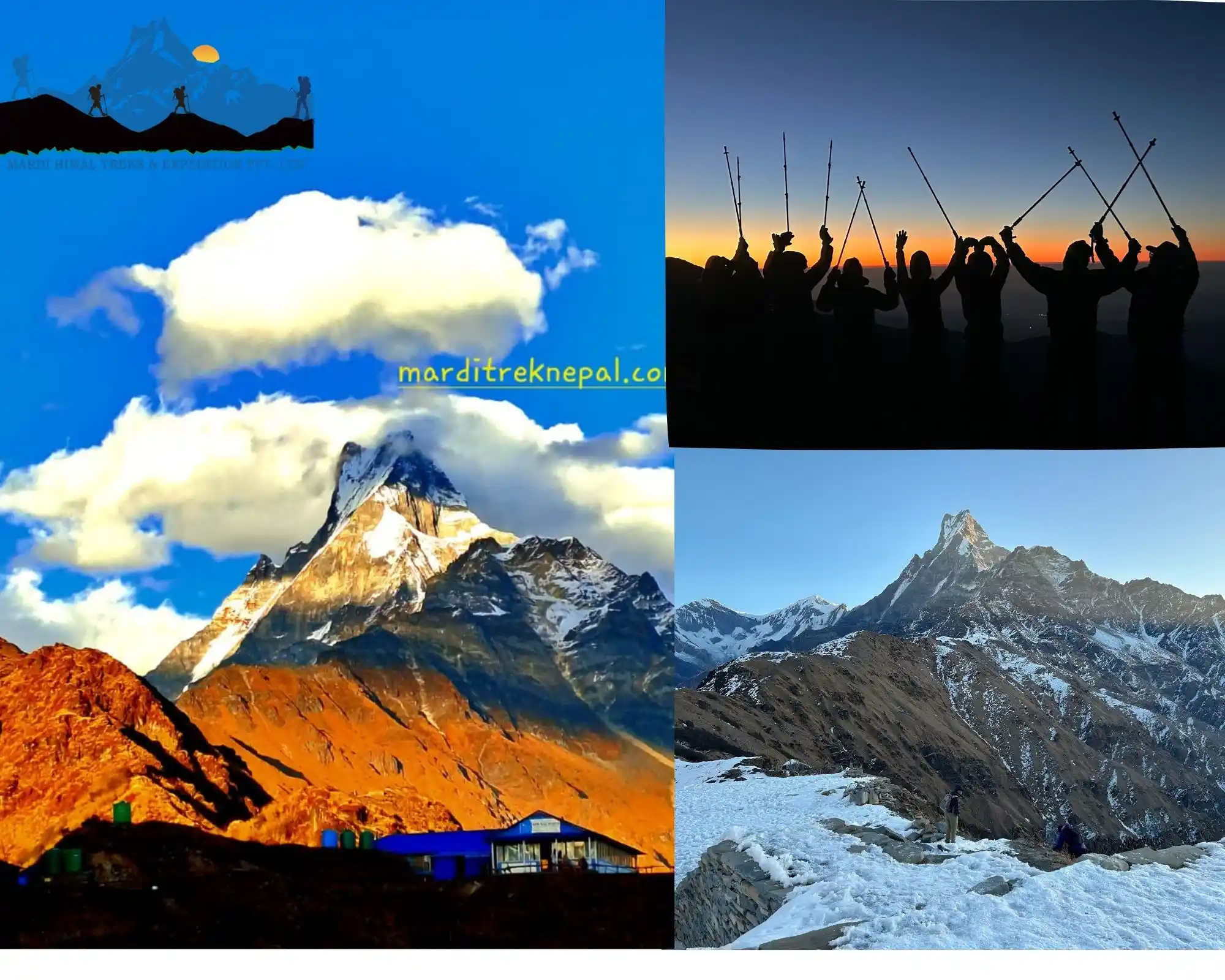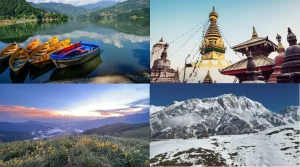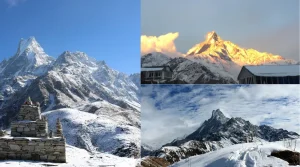If you’re yearning for a trekking adventure that combines breathtaking views, a sense of tranquility, and a touch of challenge, then the Mardi Himal Trekking Experience in Nepal is calling your name. As you leave the bustling streets of beautiful Pokhara, the journey towards the shadow of Annapurna range will be the ultimate scenic adventure and treat to your eyes.
The ever-changing landscapes, the lush greenery of rhododendron forests opens up to the alpine meadows. The crystal clear streams that flow through the heart of this land whisper ancient tales of these mountains.
As it lies in the majestic Annapurna region, this trek offers an unforgettable experience that will leave you awestruck. This Mardi Himal Trek Scenic Guide lets you delve into everything you need to know about this incredible journey, from the route map to the itinerary, and everything in between.
Why Choose the Mardi Himal Trek?
Do you wish to see the golden glow on the Annapurna or sunset in Fishtail? Imagine the peace you will experience in the less popular trails as compared to other beautiful yet crowded routes like Annapurna Base Camp Trek, this Mardi Himal Trekking experience is your chance to connect with nature, culture and yourself, leaving your heart full and your spirit inspired.
A Hidden Gem in the Himalayas
The Mardi Himal Trek is a hidden gem in the Annapurna region of Nepal, offering a quieter and less crowded alternative to the more popular treks in the Himalayas. It takes you through lush forests, charming villages, and ultimately rewards you with stunning views of the Annapurna range, including the majestic Machapuchare, also known as the “Fishtail” mountain.
Diverse Landscape Experience
The trek takes you through a variety of landscapes, each more stunning than the last. You’ll start in sub-tropical forests filled with vibrant rhododendrons in spring and bamboo groves. As you go higher, the landscape gradually changes to alpine meadows and rugged mountainous terrain, offering a diverse trekking experience that is both visually and physically rewarding.
Off-the-Beaten-Path Adventure
One of the biggest draws of the Mardi Himal Trek is its off-the-beaten-path appeal. This trek provides an intimate experience with nature, far removed from the bustling crowds of other trails. The peacefulness of the journey allows trekkers to connect with their surroundings, offering a meditative trekking experience that is not easy to find on more popular routes in Nepal.
Rich Cultural Immersion
The trek also offers an enriching cultural experience, as it passes through several traditional villages. Here, you can witness the daily lives of the Gurung and Magar communities. Their hospitality is legendary, and you’ll have opportunities to engage with locals, partake in traditional meals, and learn about the rich cultural heritage that defines this region.
Understanding the Mardi Himal Trek Route Map
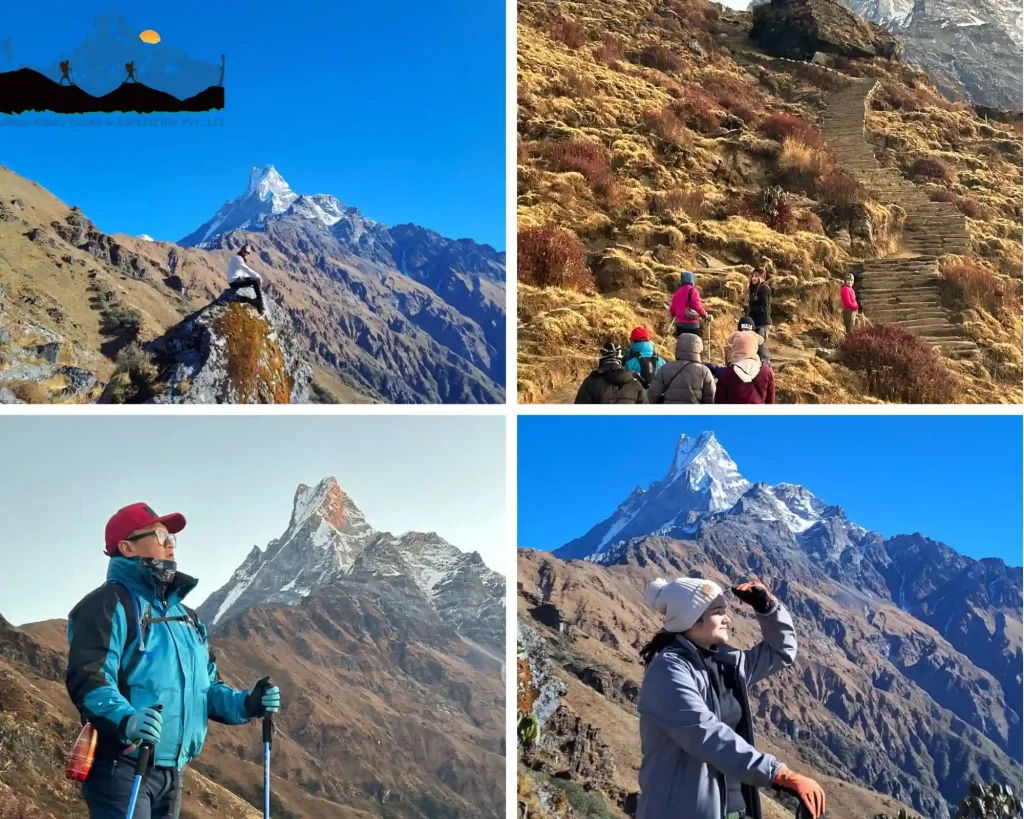
Before embarking on your adventure, it’s essential to familiarize yourself with the Mardi Himal Trek route map. The trek typically begins from the picturesque city of Pokhara, which serves as the perfect launching pad for your Himalayan journey.
Starting Point: Pokhara
Pokhara is not just a starting point; it’s a destination in its own right. Known for its serene lakes and stunning mountain views, it offers a perfect place to relax and prepare before your trek. Explore the vibrant markets, enjoy a boat ride on Phewa Lake, or take in the views of the Annapurna range and Machapuchare from the city’s viewpoints.
Pokhara to Kande: The Journey Begins
The drive from Pokhara to Kande is a short yet scenic journey. As you leave the city behind, the landscape shifts to rolling hills and terraced fields. This one-hour drive sets the tone for the trek, offering a glimpse of the natural beauty that lies ahead. Kande is a small village where you can catch your breath and make final preparations before hitting the trail.
Kande to Forest CampMardi Him: Into the Wilderness
From Kande, the trek begins in earnest. The trail to Forest Camp is a gentle ascent through lush forests, filled with the sounds of chirping birds and rustling leaves. As you walk, take time to appreciate the rich biodiversity of the region, with chances to spot various wildlife and unique plant species. The trail is well-marked and relatively easy, making it accessible for trekkers of all levels.
Complete Mardi Himal Trek Itinerary
Creating a well-structured itinerary is crucial for making the most of your Mardi Himal Trek. Here’s a suggested itinerary that balances adventure, acclimatization, and relaxation:
Day 1: Pokhara to Kande to Forest Camp
Travel: Drive from Pokhara to Kande (1 hour)
Trek: Kande to Forest Camp (approximately 4-5 hours)
Highlights: Stunning views, lush forests
This first day sets the pace for your adventure. As you ascend through the forest, you’ll pass through Australian Camp and Pothana, offering panoramic views of the Annapurna range. The lush greenery provides a refreshing backdrop, and the tranquil environment helps you ease into the trekking routine.
Day 2: Forest Camp to Low Camp
Trek: Forest Camp to Low Camp (approximately 3-4 hours)
Highlights: Rhododendron forests, emerging mountain views
Day two takes you through enchanting rhododendron forests, especially magical during spring when the flowers are in full bloom. The trail is a gentle climb, and as you gain elevation, the mountain views become more prominent. Low Camp offers a cozy resting spot with views of Machapuchare peeking through the trees.
Day 3: Low Camp to Mardi Himal High Camp
Trek: Low Camp to High Camp (approximately 3-4 hours)
Highlights: Panoramic views, diverse landscapes
The trek to Mardi Himal High Camp is a journey into the alpine zone. The vegetation becomes sparser, replaced by rugged landscapes and unobstructed views of the surrounding peaks. High Camp is perched on a ridge, offering breathtaking 360-degree views. Spend the evening soaking in the sunset and preparing for the next day’s adventure.
Day 4: High Camp to Mardi Himal Base Camp and Return
Trek: Mardi Himal High Camp to Mardi Himal Base Camp and return (approximately 6-7 hours)
Highlights: Breathtaking sunrise, close-up mountain views
This is the most challenging yet rewarding day of the trek. An early start allows you to witness a stunning sunrise over the Himalayas. The trek to Base Camp is demanding but offers unparalleled close-up views of Machapuchare and the Annapurna range. The sense of accomplishment and the vistas make every step worthwhile.
Day 5: High Camp to Siding Village
Trek: Mardi Himal High Camp to Siding Village (approximately 5-6 hours)
Highlights: Descending through forests, village life
On day five, you’ll descend through lush forests and terraced fields to Siding Village. This descent is a chance to reflect on the journey as you re-enter the world of vibrant greenery. Siding is a charming village where you can interact with locals and experience traditional Nepali life firsthand.
Day 6: Siding Village to Lumre to Pokhara
Trek: Siding Village to Lumre (approximately 3-4 hours)
Travel: Drive from Lumre to Pokhara
Highlights: Relaxation, cultural experiences
The final leg of the trek is a gentle walk to Lumre, followed by a drive back to Pokhara. This day is about relaxation and reflection, as you transition from the tranquility of the mountains to the comforts of city life. Enjoy the cultural vibrancy of Pokhara, indulge in local cuisine, and celebrate the completion of your trek.
Essential Packing List for Mardi Himal Trek
Packing wisely is essential to ensure a comfortable and safe trekking experience in Nepal. Here’s a checklist of essentials to consider:
Clothing Essentials
Layered clothing is key for tackling the varying temperatures of the trek. Start with moisture-wicking base layers to keep you dry. Add insulating layers like fleece for warmth, and top it off with a waterproof jacket to protect against rain and wind. Trekking pants and thermal leggings will keep your legs comfortable, while a warm hat and gloves are essential for the colder nights at high altitude.
Trekking Gear
Invest in sturdy trekking boots with good ankle support to navigate the diverse terrains of the trek safely. Comfortable, moisture-wicking socks will prevent blisters and keep your feet dry. Equip yourself with trekking poles for stability on uneven paths, a reliable backpack to carry your essentials, and a hydration system to stay adequately hydrated throughout the trek.
Miscellaneous Items
Pack a first aid kit with essentials like band-aids, antiseptic wipes, and pain relievers. Sunscreen, sunglasses, and a wide-brimmed hat will protect you from the intense mountain sun. A headlamp is crucial for early morning starts, and a camera is a must to capture the stunning scenery. Don’t forget to bring some cash, as ATMs are rare along the route.
Important Trekking Tips
Acclimatization and Altitude Sickness
While the Mardi Himal Trek is considered moderate in terms of difficulty, it’s essential to acclimatize properly to prevent altitude sickness. Take your time, stay hydrated, and listen to your body.
To aid acclimatization, consider spending an extra day at Forest Camp or Low Camp. This allows your body to adjust to the altitude gradually. Keep an eye on symptoms of altitude sickness like headaches, nausea, or dizziness, and descend if they worsen. Trekking in Nepal slowly and steadily will also help your body adapt to the Himalayan altitude.
Best Time to Trek Mardi Himal
The ideal seasons for the Mardi Himal Trek are spring (March to May) and autumn (September to November). During spring, the rhododendron forests burst into colorful blooms, creating a magical atmosphere. Autumn offers clear skies and excellent mountain visibility. Winter treks (December to February) are possible but require extra preparation for cold temperatures and potential snow. The monsoon season (June to August) brings heavy rainfall and is generally not recommended for trekking in Nepal.
Trek Difficulty Level
The Mardi Himal Trek is classified as a moderate-difficulty trek. While it doesn’t require technical climbing skills, a reasonable level of fitness is necessary. Daily trekking hours range from 3-7 hours, with the trek to Base Camp being the most challenging day. Prior trekking experience is helpful but not mandatory. Proper acclimatization and a steady pace make this trek accessible to most adventure enthusiasts.
Respect Local Culture and Traditions
As you journey through charming villages, remember to respect local customs and traditions. Engage with locals, learn a few Nepali phrases, and support local businesses by staying in teahouses.
Nepali culture is rich and diverse, with deep-rooted traditions. Show respect by dressing modestly, especially in villages. Participate in local customs when invited, such as enjoying a meal or joining a festival. By embracing the local culture, you’ll enrich your trekking experience and create meaningful connections with the Gurung and Magar communities.
Enjoy the Journey
Trekking is as much about the journey as it is about the destination. Take time to savor the views, enjoy the camaraderie of fellow trekkers, and immerse yourself in the natural beauty that surrounds you.
Every step of the trek offers something unique, from the whispering forests to the towering peaks of the Himalayas. Capture these moments in your memory, and take breaks to absorb the majesty of your surroundings. Engage with fellow trekkers and share stories, creating bonds that will last long after the trek ends.
Permits and Regulations
To trek in the Mardi Himal region, you’ll need two permits: the Annapurna Conservation Area Permit (ACAP) and the Trekkers’ Information Management System (TIMS) card. These permits can be obtained in Pokhara or Kathmandu through registered trekking agencies or the Nepal Tourism Board office. Carry these permits with you at all times, as they will be checked at various checkpoints along the route. The permit fees contribute to conservation efforts and local community development in Nepal.
Accommodation and Food
Along the Mardi Himal Trek route, you’ll stay in teahouses and lodges that offer basic but comfortable accommodation. Rooms are typically simple, with twin beds and shared bathroom facilities. As you ascend to higher altitudes, facilities become more basic. The teahouses serve a variety of meals, including traditional Nepali dal bhat (rice and lentils), as well as international dishes like pasta, noodles, and soups. The food is freshly prepared and provides the necessary energy for trekking. Supporting these local establishments helps sustain the mountain communities.
Cost and Budget Planning
The Mardi Himal Trek is one of the more affordable treks in Nepal. Our standard Mardi Trek Package starts from $700. This package consists of the porter and the licensed guide. The itinerary is 9 days long but if you wish to enjoy the Mardi Himal Trekking Experience on a budget, it can be done by consulting Mardi Himal Treks and Expedition for the custom itinerary.
Budget trekkers can complete the trek for approximately $250-400, covering permits, accommodation, meals, and transportation. Mid-range budgets of $500-800 allow for more comfortable teahouses and guide services. The cost varies depending on whether you trek independently or hire a guide and porter. Hiring a local guide (approximately $25-30 per day) enhances the experience with local knowledge and ensures safety, while porters ($15-20 per day) can carry your heavy backpack, making the trek more enjoyable.
However, there are extra expenses for your personal expenses if you wish to enjoy drinks or the tips for porters and guides. Tipping is not forced but it is customary in Nepal to show gratitude for the help and company during travel.
Conclusion
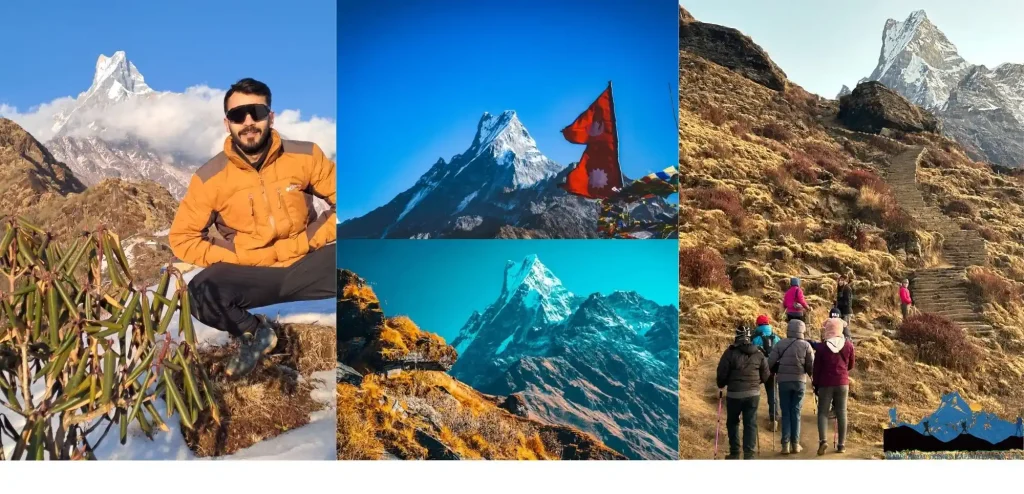
The Mardi Himal Trek is a hidden paradise that promises an unforgettable adventure in the heart of the Himalayas. From the awe-inspiring vistas to the warm hospitality of the locals, every step of the journey offers a unique and enriching experience. Whether you’re seeking a challenging Himalayan adventure, cultural immersion, or simply a peaceful escape into nature, this trek in Nepal delivers on all fronts. So, lace up your boots, grab your map, and get ready to explore the scenic wonders of Mardi Himal. Happy trekking!
FAQs (Frequently Asked Questions)
What is the highest point of the Mardi Himal Trekking Experience?
The highest point of the Mardi Himal Trekking Experience is the Mardi Himal Base Camp at an altitude of 4500 m. However, there are no accommodations here meaning you have to stay on the Mardi Himal High Camp at around 3600 m.
Where is Mardi Himal located?
The Mardi Himal is located in the Annapurna region of Nepal near Pokhara. It is at the base of Annapurna massif just beside the Mount Machhapuchare(Fishtail) and surrounding peaks like Hiunchuli, Annapurna South and other Himalayan peaks.
Is Mardi Himal for beginners?
Yes, the Mardi Himal Base Camp trek is ideal for beginners. This short and scenic trek in the Annapurna region is perfect for first-time trekkers who want to experience the Himalayas in the high altitude without extreme difficulty.
How difficult is Mardi Himal Trek?
The Mardi Himal Trek difficulty is considered moderate and suitable for beginners with basic fitness. The Mardi trail includes steep sections but requires no technical climbing as there is a proper route for trekkers.
How high is Mardi himal base camp?
Mardi Himal Base Camp sits approximately at an altitude of 4500 m which is 14,763 ft above the sea level. At this altitude, there is snowfall during cold seasons and trekkers can enjoy the stunning views of Mardi, Machhapuchare(Fishtail), Annapurna South, Hiunchuli and other surrounding peaks.
Is a guide mandatory for Mardi himal?
Yes, it is mandatory to hire a licensed guide through a government registered trekking agency in Nepal. This rule was enforced by Nepal Tourism Board ensuring trekkers’ safety, proper navigation, and support in emergencies.
What is the elevation of Mardi peak?
Mardi peak lies in the Annapurna region at an altitude of 5,587 meters above sea level. It lies just below the majestic Machhapuchare(Fishtail) and is considered a trekking peak, ideal for beginners.


